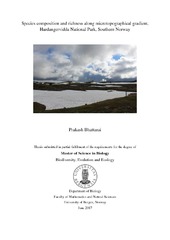Species composition and richness along microtopographical gradient, Hardangervidda National Park, Southern Norway
Master thesis
Permanent lenke
https://hdl.handle.net/1956/16418Utgivelsesdato
2017-08-23Metadata
Vis full innførselSamlinger
Sammendrag
Snow, an effective insulator and a mediator of soil microclimate, determines the abundance and plant species richness patterns in the alpine life zone. The aims of this study are: first, to investigate the species composition of lichens and vascular plant species and relate it with microtopography at fine scale, second, to show the pattern of species richness of total plant species and other life forms with weighted average snow indicator values and third, to investigate whether microtopography causes any significant differences in species richness for total plant species and other life forms. All species (69) in 151 plots of 4 m2 in 23 transects were used in the analysis. I performed detrended correspondence analysis to explore how microtopographical gradient was related to the variation in the species composition. Afterwards, the weighted average snow indicator value was calculated and used as snow cover gradient. A generalised linear model was used to reveal species richness patterns along the snow cover gradient. One-way ANOVA was performed on the 69 plots, distributed on the 23 transects to identify topographic variability in species richness. DCA analysis reveals that the first axis represents the complex gradient from snow free ridge to wet snowbed habitats and the second axis represents a gradient from acidic to calcareous sites. Species richness for total plant species, vascular plant species and herbaceous plant species increased with increase in WASI value, whilst species richness for lichen species declined substantially towards the maximum weighted average snow indicator value. In contrast, species richness for dwarf shrub species showed a unimodal relationship with hump shaped pattern against WASI. Lichen’s species richness is greater in ridge and less in snowbeds, while all other life forms follow the opposite trend. Here, liquid water availability determines species richness in mountains, particularly in my study which is controlled by snow cover and prevalent wind direction. The short growing season limits species richness, although there is enough available water, which shows that time is an important vector that determines the species richness along the microtopographical gradient. Hence, this study illustrates that small-scale data reveals local variations, which are overlooked when using regional scale data, but provide important knowledge on how to optimise predictions for plant species composition and richness in space and time.
